Short Book Reviews
Hanna Kryszewska, Poland
Hanna Kryszewska is a teacher, teacher trainer, trainer of trainers. She is a senior lecturer at the University of Gdańsk, and EU Teacher Training College where she trains pre-service teachers. She is co-author of resource books: Learner Based Teaching, OUP, Towards Teaching, Heinemann, The Standby Book, CUP, Language Activities for Teenagers, CUP, The Company Words Keep, DELTA Publishing, and a course book series for secondary schools: ForMat, Macmillan. She is also co-author of a video based teacher training course: Observing English Lessons. Hania is a Pilgrims trainer and editor of HLT Magazine.
E-mail: hania.kryszewska@pilgrims.co.uk

Helbling Young Readers Fiction. Helbling Languages (2014). e.g. Dad for Sale. Andres Pi Andreu ISBN-13: 978-3-85272-954-1, pp 32, The Big Wave. Stefanella Ebhardt ISBN-978-3-85272-953-4, pp 32, and Lola in the Land of Fire. Rick Sampedro ISBN-978-3-85272-957-2 The Big Wave. Stefanella Ebhardt ISBN-978-3-85272-953-4, pp 32., pp 32.. Books in this new series of graded reading materials for young learners of English are at the Starters and Movers levels according to the YLE, or levels 1-3 according to the Trinity Exams scale. The stories are interesting and told in basic English using simple grammar: present tenses and modal verbs, and basic vocabulary. Apart from language input and practice, the stories have a message such as: the same place can be perceived differently by different people, or that you need to help especially if you are the only one who can help. Before the students either hear the story from the CD or read by the teacher following it in the book, they do some exercises in the Play station section which pre-teaches and activates the language the learners need to follow the story. The activities which are on the CD-ROM are interactive and fun. The stories themselves are very good and often charming, and on each two page spread there is a little icon, a bug, a duck or a crab which gives the readers an extra task such as answering a personal question, working your way through a maze or spotting something in the picture. At the end of each book there is Play Station 2 section which revises some of the language in the story, or a Play Station Project like making a sand bottle, or making a board game. There is also a mini dictionary. The font is young reader friendly, and the books are beautifully illustrated. The CD-ROM contains an audio book and some activities, language games, karaoke, chants, story sequencing activities and an audiovisual dictionary. Highly recommended.

Macmillan Children’s Readers. Fact & Fiction. Level 1-6. Different authors, photographers and illustrators. Macmillan. (2015). e.g. Clothes We Wear ISBN 978-0-230-46919-8, pp 24, Fun at the Beach, ISBN 978-0-230-46920-4, pp.24, Big and Little Cats ISBN 978-0-230-46921-1, pp 32, Chocolate, Chocolate Everywhere!, ISBN 978-0-230-46922-8, pp.32, The Wild West ISBN 978-0-230-46923-5, pp 32, and Edinburgh, ISBN 978-0-230-46924-2, pp.32.
This new six level series of readers is intended for young learners aged 7-10. The new titles in the series include a variety of topics suitable for the given language level and age group. Overall the books follow a similar pattern; first come facts with realistic photography, then a comic strip, and finally some language activities and a picture dictionary. However, at higher levels there are also some reading comprehension exercises. The language input (grammar and vocabulary) are carefully graded. Certain grammar structures and lexical items are introduced in the first part of the book, then reinforced in the comic story and practised in the activity section. The books are ideal for lessons supplementing the coursebook or introducing CLIL. This is a very good combination as young learners are interested in learning English but above all they are hungry to learn about the surrounding world. The readers tap into this need perfectly and they are also ideal for a reading corner. As the books have been written by different authors and the artwork comes from different illustrators, they are not repetitive from title to title. Each one you pick up feels fresh and different. The teachers get a lot of support; there are additional audio downloads and teacher resources which are available at:
www.macmillanyounglearners.com/readers
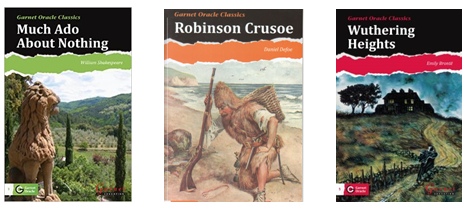
Garnet Oracle Classics. Garnet Education.
Level 3 - Much Ado About Nothing. ISBN 978-1-78260-227-9, pp 56. (2014)
Level 4 – Robinson Crusoe. ISBN 978-1-78260-228-6, pp 64. (2014)
Level 5 – Wuthering Heights. ISBN 978-1-78260-229-3, pp 80. (2014)
Readers in this series of graded reading materials for language learners come at five levels (level 3 – 1000 headwords, level 3 – 1250 headwords, level 5 - 1500 headwords). They are carefully graded, both lexically and structurally. The aim of the series is to familiarise learners of English literature, and to encourage them to read for pleasure and speed. The stories by William Shakespeare, Daniel Defoe and Emily Bronte are very skillfully retold by Peter Viney, and are a pleasure to read. The stories are accompanied by information about the author, resource pages, activity pages and a glossary explaining some of the more difficult words used in the text. At the moment there are four titles available at each level. Let us hope there are more to come. For more go to:
www.garneteducation.com
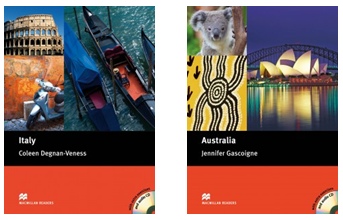
Macmillan Readers: Italy. C. Degnan-Veness. (2015). ISBN 978-0-023-0-47016-3, pp 90; Australia. J. Gascoigne. (2015). ISBN 978-0-230-47025-5, pp 104. The Macmillan Readers series is well established on the ELT market. It provides a variety of extensive reading texts at six levels. Some of the titles are retold versions of classics or popular modern books, others are stories specially written for the series. These two titles are different as they are devoted to individual countries and have a strong CLIL angle. The readers come at various levels Italy – pre-intermediate, and Australia – upper-intermediate. The readers do not follow the same template; some focus more on history, others on geography, culture or tradition. The readers are informative, beautifully illustrated with good quality photographs and a pleasure to read. They come with extra grammar and vocabulary exercises, some comprehension questions, a glossary of difficult vocabulary and useful phrases, an audio CD (or audio download to be bought online), free resources online with worksheets, tests and answer keys. The readers are a very good way to introduce CLIL and culture to ELT classes.
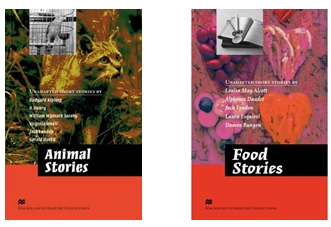
Macmillan Literature Collections. Animal Stories. ed. C. Jones. Macmillan (2015) ISBN – 978-0-230-47029-3, pp 220. Food Stories. ed. D. Barber. Macmillan (2015) ISBN – 978-0-230-46391-2, pp 206. Books in this new series contain unadapted short stories by well known classic and modern authors. The stories are gathered around a theme, such as food (by L.A. Alcott, A. Daudet, J. London, L. Esquivel and D. Runyon) or animals (by R. Kipling, O. Henry, W.W. Jacobs, V. Woolf, J. London and G. Durell). Each collection starts with an introduction explaining the genre of a short story, preparing the reader for reading authentic literary texts in English, preparing oneself for a story, dealing with difficult passages, and dealing with difficult words. As for the latter there is a special section on using a dictionary, looking up words and keeping a record of the words the reader has looked up. Each individual story is introduced through information about the author, information about the story and background information. Then the readers can read a summary of the story but it does not reveal how the story ends. Before the readers encounter the text of the story they may choose to do the pre-reading activities which refer to the key vocabulary and main themes in the story. After the text of the short story, the learners can do post-reading activities on understanding the story, language study (e.g. grammar and linkers) and literary analysis with essay questions. The key to all the activities can be found on-line. This is fantastic resource for advanced language learners, both to be used in class and for self study. Highly recommended.
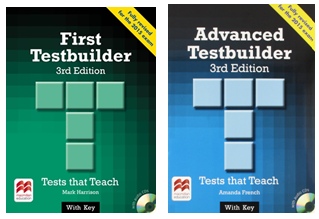
Tests that Teach: First Testbuilder 3d Edition. M. Harrisson. Macmillan (2014) ISBN 978-0-230-47611-0, pp 175. Tests that Teach: Advanced Testbuilder 3d Edition. A. French. Macmillan (2015) ISBN 978-0-230-47620-2, pp 176. The books are aimed at candidates that would like to succeed in the revised Cambridge English First (FCE) and Advanced (CAE) exams respectively. As of 2015 both the exams have a new format and they have been shortened. Now there are 4 parts: Reading and Use of English, Writing, Listening and Speaking. Macmillan Testbuilders series have a unique formula as the learners not only practise exam-style questions but they also get a lot of guidance, extra language practice and insights into successful exam strategies. They receive comprehensive advice on how to succeed in the individual parts of the exam, and the key at the end of the book not only gives the correct answer but in the case of some exams tasks explains why the other answers/options are wrong. Each book contains four full exam papers, visual material for the speaking test and is complete with two CD’s. The books are suitable for class use and for self-study as the books can be purchased with or without a key at the end of the book.
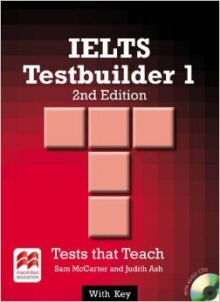
Tests that Teach: IELTS Testbuilder 1. 2nd Edition. S.McCarter and J. Ash. Macmillan (2015) ISBN 978-0-230-47614-1, pp 168. The book is aimed at candidates who would like to succeed in the IELTS exam, and would aim at grades from 5.5 to 7.0 in the academic version of the exam. Learners can practise exam-style questions paper-by-paper. Macmillan Testbuilders series have a unique formula as the learners not only practise exam-style questions but they also get a lot of guidance and insight into successful exam strategies. Learners receive comprehensive advice on how to succeed in the individual parts of the exam, and the key at the end of the book not only gives the correct answer but in the case of some exams tasks explains why the other answers are wrong. The book contains four full exam papers and is complete with two CD’s with the audio material. The books are suitable for class use and for self-study as the books can be purchased without or with a key. NB. I am unable to judge how the 2nd Edition differs from the 1st Edition, and whether the texts and tasks have been recycled or whether they are completely new.

Vocabulary. As Easy As ABC: Dispelling Myths & Building Bridges Towards Proficiency D. Thanasoulas. Perugia. (2014). ISBN 978-618-81441-1-8, pp 168. The book is suitable for candidates who want to take English Language exams at the B2-C2 levels. The book provides ample vocabulary practice and thorough coverage of thousands of vocabulary items in context. The book is innovative in its organisation. The lexical items appear in the book in alphabetical order, however, the exercises vary in their nature, e.g. matching, multiple choice, and odd-one-out. One could say it is a linear book, which is not related to any particular exam or a particular topic umbrella; it is basically good additional vocabulary practice, especially if the students are beginning to feel tired of the format of the exam they are preparing for. The book is suitable for class use and for self-study as it comes with a key at the end.
Idioms. What’s the Idiom for? D. Thanasoulas. Perugia. (2014). ISBN 978-618-81441-0-1, pp 166. The book is suitable for candidates who want to take English language exams at the B2-C2 levels and/or who want to improve their translation skills. The book provides coverage of over 700 idioms through texts contextualising the idioms and a variety of exercises, listening activities, and translation into or from Greek. The latter feature makes the publication more suitable for the Greek market than for the international one. The book is suitable for class use and for self-study as it comes with a key at the end.
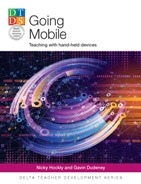
Going Mobile. Teaching with hand-held devices. N. Hockly and G. Dudeney. DELTA Publishing. (2014). ISBN 978-1-909783-06-5, pp120. This book has been published in the well established DELTA Teacher Development Series. The aim of the book is to explain and demonstrate how mobile devices can be used in an ELT class in a ‘principled and pedagogically sound way’. Indeed the introduction explains the idea of mobile learning and its importance in the 21st century. The authors then go on to talk about who mobile learning is for, what kind of equipment is or might be needed, different models of implementation of technology in ELT classes, and the various challenges teachers and learners may face. (For the last two the authors give examples from classrooms from all over the world). The main body of the book contains about approximately 50 activities divided into chapters on using texts, images, audio, and video. The activities are innovative refreshing and will surely engage and motivate language learners. Highly recommended. For sample pages go to:
www.deltapublishing.co.uk/titles/methodology/going-mobile
and for an interview with Gavin Dudeney go to:
www.deltapublishing.co.uk/development/gavin-dudeney-talks-about-going-mobile
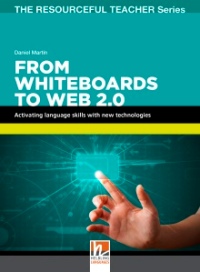
From Whiteboards to WEB 2.0. Activating language skills with new technologies. D. Martin. Helbling Languages. (2015). ISBN 978-3-85272-939-8, pp212. This book has been published in The Resourceful Teacher Series which is written by prominent figures in English Language Teaching. It offers innovative activities which are explained step by step, and are virtually ready to be used in the class. The book in question addresses one of the new areas which has relatively recently come into focus, i.e. using IT in language teaching. Daniel Martin is the author of a Helbling book: Using Interactive Whiteboards. In his new resource book in the same series he takes us to a next level. The book guides teachers to popular web tools which can help us create activities using IT. The activities can be used in class and outside the class, and they maximise the learners‘ language learning. The book starts with an introduction which explains how to use the book, how to use technologies, and considerations we need to make when using the internet.Then introdcutions to the individual chapters follow: on using Interactive Whiteboards (IWBs), using Web 1.0 and Web 2.0, and finally moving from using IWBs to using Web 2.0. The practical acivities are divided into 3 main sections: image-based activities, sound-based activities, and text-based activities. Overall there are around 80 activities which can be dipped into and explored in class, or modified to your liking so that they suit your learners‘ real needs and the teacher’s classroom practice and possibilities. Many teachers will appreciate the Further Resources section with many links and Teacher’s quick reference guide helping the teachers how to select the right activity for their class. For more on the book go to: old.hltmag.co.uk/oct14/teach.htm
and www.helblinglanguages.com/fromwhiteboards/
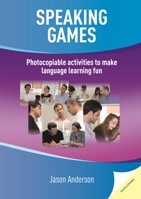
Speaking Games. Photocopiable activities to make language learning fun. J. Anderson. (2014) DELTA Publishing. ISBN 978-1-905085-98-9, pp. 128. This photocopiable resource book for classroom use is aimed at language classes in which students practise their speaking and communicative skills. The book contains 50 photocopiable ideas and relevant materials which involve genuine communication between the learners. The activities involve pairwork, groupwork and whole class games. The activities can be used to liven up coursebook-based lessons, and to promote authentic interaction, competition, language play and performance evaluation. The games involve using functional language, specific grammar structures and lexis. The learners also practise genuine communication and comprehension skills when cracking the rules of the activities. The activities fall into four types: board games, card games, secrets and lies, and quizzes, puzzles and challenges. The activities are pitched at C1/B1/B2 levels, but they are adaptable to lower levels.
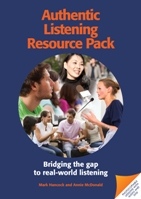
Authentic Listening Resource Pack. Bridging the gap to real-world listening. M. Hancock and A. McDonald. (2014) DELTA Publishing. ISBN 978-1-905085-88-0, pp. 144. This resource book for classroom use is aimed at language classes in which students practise their real life listening skills. The book contains 36 activities which include pre-listening/ pre viewing tasks, while listening/ while viewing tasks of various kinds, and then extension and review activities. The topics which are divided into 9 thematic groups include: feeling good, the weather, fame, going places, risk, advertising, university and many others. Another regular feature in the book are 9 pronunciation sections which look at the relationship between pronunciation and listening, for example: connected speech and weak forms, variable vowel sounds, emphasis, and intonation.The book comes with 2 CDs which contain the audio tracks and 1 CD with video extracts.

Please check the Methodology and Language for Primary Teachers course at Pilgrims website.
Please check the Methodology and Language for Secondary Teachers course at Pilgrims website.
Please check the Teaching Advanced Students course at Pilgrims website.
Please check the CLIL for Primary Teachers course at Pilgrims website.
Please check the CLIL for Secondary Teachers course at Pilgrims website.
Please check the Teaching Languages Using Technologies course at Pilgrims website.


|